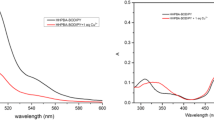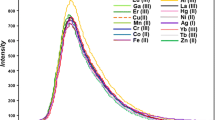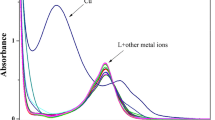Abstract
A novel naphthalene-Bodipy dye (N-Bodipy) was designed, prepared and characterized. N-Bodipy showed a selective and sensitive recognition toward Cu(II) ions as a fluorescent antenna group in aceto-nitrile/water over other metal cations. The complexation between Cu(II) ions and N-Bodipy gave a specific color change as well as caused fluorescence quenching under long-wavelength light (365 nm). The remarkable quenching effect in fluorescence intensity centered at 538 nm was only observed in the presence of copper(II) ions. Moreover, the orange color of N-Bodipy solution turned pale-yellow depending on the complexation effect in daylight. The complex stoichiometry was determined using a Job's plot and it was found to be 2: 1 (ligand/metal). The binding constant was calculated with the Benesi-Hildebrand equation to be 1.39 x 1010 M−1 and the detection limit was 1.28 μM (LOD = 3α/slope, α is the standard deviation) for Cu(II). The data proved that the binding between N-Bodipy and Cu(II) is chemically reversible.
Similar content being viewed by others
References
K. Mariappan, M. Alaparthi, G. Caple, V. Balasubramanian, M. M. Hoffman, M. Hudspeth and A. G. Sykes, Selective Fluorescence Sensing of Copper(II) and Water via Competing Imine Hydrolysis and Alcohol Oxidation Pathways Sensitive to Water Content in Aqueous Acetonitrile Mixtures, Inorg. Chem., 2014, 53, 2953–2962.
C. Y. Chou, S. R. Liu and S. P. Wu, A highly selective turn-on fluorescent sensor for Cu(II) based on an NSe2 chelating moiety and its application in living cell imaging, Analyst, 2013, 138, 3264–3270.
EPA National Primary Drinking Water Regulations, http://water.epa.gov/drink/contaminants/index.cfm#1 (accessed Dec 4, 2012).
A. P. S. Gonzales, M. A. Firmino, C. S. Nomura, F. R. P. Rocha, P. V. Oliveira and I. Gaubeur, Peat as a natural solid-phase for copper preconcentration and deter-mination in a multicommuted flow system coupled to flame atomic absorption spectrometry, Anal. Chim. Acta, 2009, 636, 198–204.
C. Shi, S. Xie and J. Jia, The Study of a New Method to Determine Copper Ion by Square-Wave Voltammetry-Extraction Iodometry at the Liquid/Liquid Interfaces, J. Autom. Methods Manage. Chem., 2008, 2008, 453429–453433.
Y. Liu, P. Liang and L. Guo, Nanometer titanium dioxide immobilized on silica gel as sorbent for preconcentration of metal ions prior to their determination by inductively coupled plasma atomic emission spectrometry, Talanta, 2005, 68, 25–30.
J. Zhanga, B. Zhaoa, C. Lia, X. Zhub and R. Qiao, A BODIPY-based “turn-on” fluorescent and colorimetric sensor forselective detection of Cu2+ in aqueous media and its application in cell imaging, Sens. Actuators. B, 2014, 196, 117–122.
P. Anzenbacher, P. Lubal, P. Bucek, M. A. Palacios and M. E. Kozelkova, A practical approach to optical cross-reac-tive sensor arrays, Chem. Soc. Rev., 2010, 39, 3954–3979.
T. C. Pearce, S. S. Schiffman, H. T. Nagle and J. W. Gardner, Handbook of Machine Olfaction: Electronic Nose Technology, Wiley-VCH Verlag Gmbh & Co, KGaA, Weinheim, 2003.
O. R. Mi-randa, H. T. Chen, C. C. You, D. E. Mortenson, X. C. Yang, U. H. F. Bunz and V. M. Rotello, Enzyme-Amplified Array Sensing of Proteins in Solution and in Biofluids, J. Am. Chem. Soc., 2010, 132, 5285–5289.
N. S. Lewis, Comparisons between Mammalian and Artificial Olfaction Based on Arrays of Carbon Black-Polymer Composite Vapor Detectors, Acc. Chem. Res., 2004, 37, 663–672.
F. Rock, N. Barsan and U. Weimar, Electronic nose: Current status and future trends, Chem. Rev., 2008, 108, 705–725.
A. T. Wright and E. V. Anslyn, Differential receptor arrays and assays for solution-based molecular recognition, Chem. Soc. Rev., 2006, 35, 14–28.
Y. Wu, N. Na, S. Zhang, X. Wang, D. Liu and X. Zhang, Discrimination and identification of flavors with catalytic nanomaterial-based optical chemosensor array, Anal. Chem., 2009, 81, 961–966.
S. H. Lim, L. Feng, J. W. Kemling, C. J. Musto and K. S. Suslick, An Optoelectronic Nose for Detection of Toxic Gases, Nat. Chem., 2009, 1, 562–567.
L. Feng, C. J. Musto and K. S. Suslick, A Simple and Highly Sensitive Colorimetric Detection Method for Gaseous Formaldehyde, J. Am. Chem. Soc., 2010, 132, 4046–4047.
G. F. Nordberg, B. A. Fowler, M. Nordberg and L. Friberg, in Handbook on the Toxicology of Metals, Academic Press, Burlington, MA, 3rd edn, 2007.
P. Pohl, Determination of metal content in honey by atomic absorption and emission spectrometries, TrAC, Trends Anal. Chem., 2009, 28, 117–128.
D. T. Quang and J. S. Kim, Fluoro-and chromogenic chemo-dosimeters for heavy metal ion detection in solution and biospecimens, Chem. Rev., 2010, 110, 6280–6301.
B. Valeur, Molecular Fluorescence: Principles and Applications, Wiley-VCH, Weinheim, Germany, 2001.
C. Chen, R. Wang, L. Guo, N. Fu, H. Dong and Y. Yuan, A squaraine-based colorimetric and “turn on” fluorescent sensor for selective detection of Hg2+ in an aqueous medium, Org. Lett., 2011, 13, 1162–1165.
N. Dorh, S. Zhu, K. B. Dhungana, R. Pati, F. T. Luo, H. Liu and A. Tiwari, BODIPY-Based Fluorescent Probes for Sensing Protein Surface-Hydrophobicity, Sci. Rep., 2015, 5, 18337
B. Taner, A. N. Kursunlu and E. Güler, Spectrochim. Acta, Part A, 2014, 118, 903–907
A. N. Kursunlu, E. Guler, H. I. Ucan and R. W. Boyle, Dyes Pigm., 2012, 94(3), 496–502
M. Bayrakci, A. N. Kursunlu, E. Güler and S. Ertul, Dyes Pigm., 2013, 99(2), 268–274
A. N. Kursunlu, Z. E. Koc, A. Y. Obali and E. Güler, J. Lumin., 2014, 149, 215–220.
Y. Lv, W. Wei and Y. Xie, Bodipy-Phenol-Based Sensor For Selectively Recognizing Three Basic Anions, J. Chil. Chem. Soc., 2015, 60, 2843–2846
M. Formica, V. Fusi, L. Giorgi and M. Micheloni, New fluorescent chemosensors for metal ions in solution, Coord. Chem. Rev., 2012, 256, 170
P. Hadi, P. Gao, J. P. Barford and G. Mckay, J. Hazard. Mater., 2013, 252-253, 166–170
G. Ambrosi, E. Borgogelli, M. Formica, V. Fusi, L. Giorgi, M. Micheloni, E. Rampazzo, M. Sgarzi, N. Zaccheroni and L. Prodi, PluS Nanoparticles as a tool to control the metal complex stoi-chiometry of a new thio-aza macrocyclic chemosensor for Ag(I) and Hg(II) in water, Sens. Actuators, B, 2015, 207, 1035.
J. Zhang, B. Zhao, C. Lia, X. Zhu and R. Qiao, A BODIPY-based “turn-on” fluorescent and colorimetric sensor forse-lective detection of Cu2+ in aqueous media and its appli-cation in cellimaging, Sens. Actuators, B, 2014, 196, 117–122.
X. Liu, X. Yang, H. Peng, C. Zhu and Y. Cheng, A fluo-rescent sensor for Hg2+ and Ag+ functions as a molecular switch based on click-generated triazole moiety, Tetrahedron Lett., 2011, 52, 2295–2298.
X. Liu, X. Yang, Y. Fu, C. Zhu and Y. Cheng, Novel fluo-rescent sensor for Ag+ and Hg2+ based on the BINOL-pyrene derivative via click reaction, Tetrahedron, 2011, 67, 3181–3186.
Acknowledgements
We thank the Research Foundation of the Selcuk University (BAP) for financial support of this work (under project number: 15401013). The authors express their appreciation to Prof. Dr Ersin Güler for helpful discussions.
Author information
Authors and Affiliations
Corresponding author
Rights and permissions
About this article
Cite this article
Baslak, C., Kursunlu, A.N. A naked-eye fluorescent sensor for copper(II) ions based on a naphthalene conjugate Bodipy dye. Photochem Photobiol Sci 17, 1091–1097 (2018). https://doi.org/10.1039/c8pp00137e
Received:
Accepted:
Published:
Issue Date:
DOI: https://doi.org/10.1039/c8pp00137e




